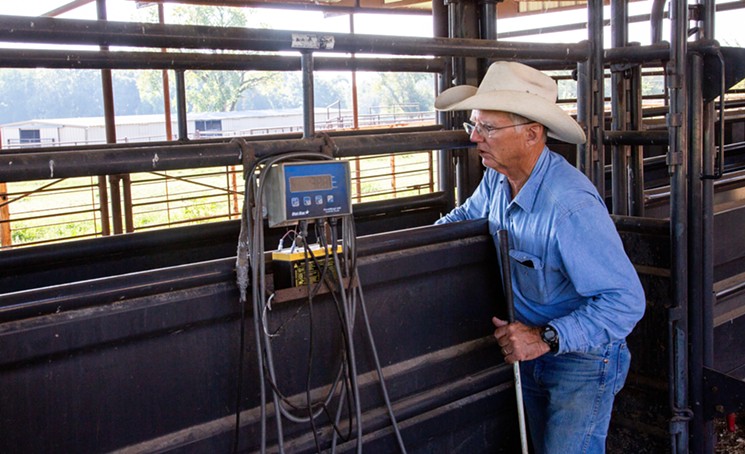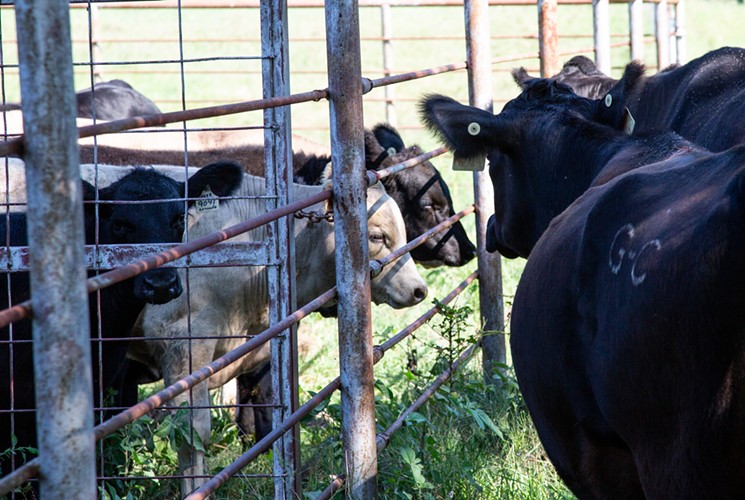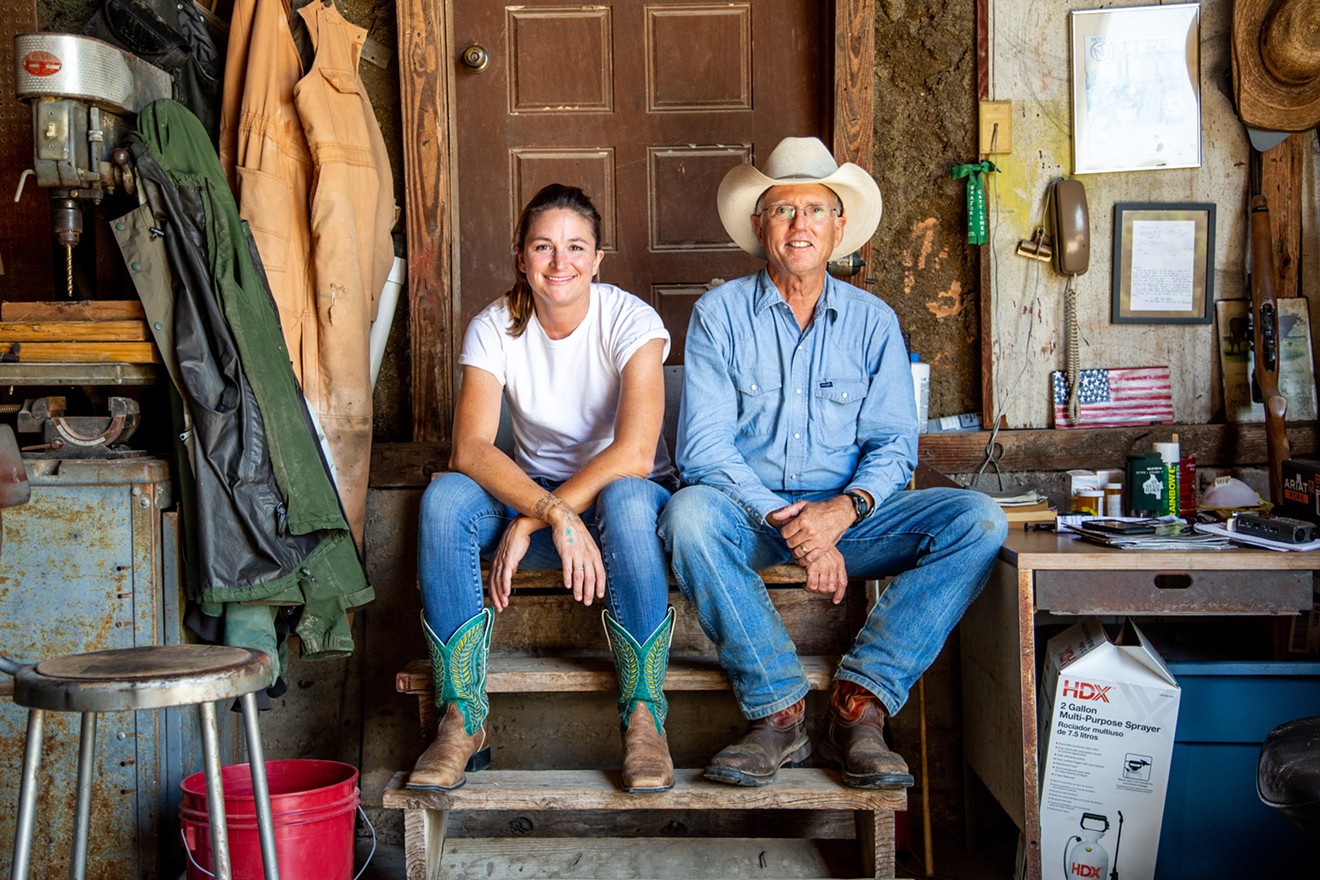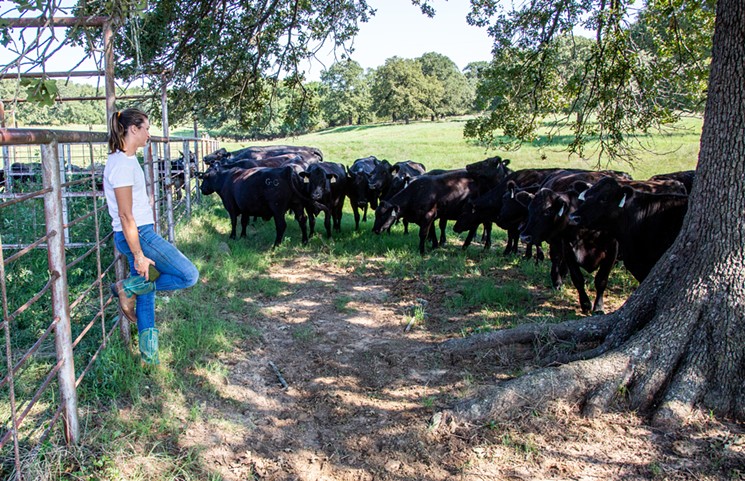“This is like candy bars to cows,” Ellis says, stopping to grab a few fluffy seed heads of native switchgrass.
“This is purple top,” she says, plucking a seed cluster off another stem and crumbling it gently so the dark, oily, burgundy seeds collect in her palm.
To the untrained eye, this pasture might look neglected and out of control, but that's all intentional. This is a rethinking of what a cattle pasture should look like, Ellis says. Ellis and her father own and ranch on nearly 3,000 aces outside Dallas and are part of a cadre of Texas ranchers who operate primarily on restored native grasslands and for whom careful care of the entire ecosystem is an essential part of the business.
“I would say that the only way to make a living at it is to do it in a sustainable way,” Ellis says. “If you’re just grazing on pasture and you’re not giving back to it, you’re just basically mining it. So grass will come back, it will try and try, but eventually there’s not enough there.”
If they are managed appropriately, native grasses help clean and conserve water and also can store large amounts of carbon in the ground, improving soil health and offering a way to offset the planet-warming greenhouse gases humans release into the atmosphere, according to the Noble Research Institute, with whom Ellis and a dozen or so other ranchers partner.
Earlier this year, the United Nations released its most severe report yet on climate change, indicating it is dangerously and irrevocably damaging the planet. The report recommends a drastic rethinking of how food is produced and grown, as well as a significant decrease in greenhouse gas emissions.
“We have a global climate problem,” says Benjamin Houlton, director of University of California, Davis' Muir Institute.
To deal with it, we need a multipronged approach that balances cutting carbon emissions and pulling carbon out of the atmosphere, he says. Native grasslands are integral to that process and well-suited to carbon sequestration, because they are drought- and fire-resistant.
“I think we have to value these ecosystems, we have to value grasslands that are promoting things that we really want to do now,” Houlton says.
Poorly managed cattle and overgrazing lead to land and ecosystem degradation and species extinction. Construction, land development and tilling also cut down on species biodiversity and disrupt the natural microbes in soil. When prairie grassland is treated well, on the other hand, it is a great water filtration system and highly effective at pulling carbon out of the atmosphere, says K.C. Olson, W.M. & F.A. Lewis Distinguished Professor in Animal Sciences and Industry at Kansas State University.
Climate change and greenhouse gas emissions have raised questions about the sustainability of our love for steak and burgers. Although ranchers lost sight of good grazing practices for a time, recently there has been a push toward conscientious land stewardship and ecosystem management, Olson says.
In Texas, a few ranchers, supported through research and education programs at the Noble Research Institute, have taken up practices that both make cattle ranching more environmentally friendly and turn their ranches into places that lock away carbon emissions from the atmosphere.
Of Ellis' 3,000 acres, roughly 1,000 are native grasslands, 1,000 are wildlife habitat and the rest are divided between Bermuda grass, which is sturdier than native grasses but does not have the same ecosystem benefits, and winter wheat, which they use as a nutrient-dense supplement for their cows. In addition to the many tree and grass species, Ellis has recorded more than 100 wildflowers, including an endangered orchid. Each spring, a bald eagle pair raises a baby by one of the pastures, and every fall and spring, monarch butterflies stop over on their migration path. Biodiversity is critical to a healthy ecosystem, and managing that means resting the land, grazing carefully and in small bursts, and limiting or eliminating synthetic fertilizers and herbicides.
In the distance, Ellis points out the stark white patch that is a new rock quarry. Nearby are dozens of fracking sites. For Ellis, ranching is not just about making a living, it’s about protecting some of the land from development. But to do that right, ranching has to be renewable, she believes.
“We're fighting for our land,” she says. Her goal is to make sure that her son never sells the land to a developer for the millions of dollars it is worth.
Instead of town houses and strip malls, her land is covered with cattle, grass, trees and flowers. Six years ago, this wild pasture was patchy and overgrazed. Instead of putting cattle on it, Ellis and her father used a combination of selective herbicides, gentle grazing and rest to give the native plants time to come back. Today, close to 30 native grass species grow in the pasture, and it resembles what it looked like hundreds of years ago. Throughout are visible thick, dusty blue stalks of big bluestem grass, which Ellis says is one of the markers of healthy soil.
“And now we’re not doing anything. It’s like back to how it should be. It’s completely native, it’s habitat, it’s a carbon sink. It’s a water filter, and the only thing we have to do now is make sure that we don’t screw it up,” Ellis says.
Going Native
Native grassland is highly drought resistant and good, nourishing food for cattle. The grasses' deep, dense root systems infuse the soil with nutrients and bind it together into an efficient water absorption system, says Jeff Goodwin, conservation stewardship leader and pasture and range consultant for the Noble Research Institute, which advises on these sustainable ranching efforts. The institute is a collection of scientists, specialists, ranchers, farmers and advisers whose goal is to study sustainable food growth techniques and make them viable and accessible.Native plants are less likely to crowd out other essential organisms or hog all of the available nutrients. Grasses also cover the ground and hold earth together, feed organic matter back into the soil, prevent erosion and keep ground temperature cool. When the earth is cool, it helps keep temperatures down, which in turn preserves important soil organisms that can be killed off by higher temperatures, Goodwin says.
When cattle trample grasses, they fertilize the land with manure and drive seeds into the ground underfoot so that they will grow the following year. Grasses like those on the great plains, which evolved with buffalo grazing on them, exist in a natural cycle with appropriately grazed herd animals, Goodwin says. Replacing the buffalo with another herd animal like cattle is essential to maintaining the grassland, biodiversity and soil, and to reaping its benefits.
Trees and grasses capture carbon dioxide from the atmosphere through photosynthesis and convert it to sugar, Houlton says. With increasing concerns about climate change and high levels of carbon dioxide and other greenhouse gases in the atmosphere, much research has focused on ways to pull some of those pollutants out of the air.
“Those sugars can go into leaves, they can go into deadwood or they can go into roots,” Houlton says. “But the decision in terms of where you allocate, that is different; trees put it above ground more and grasses put it below ground.”
Trees store roughly half the carbon they take from the atmosphere, but grasses put most of it below ground, where soil organisms convert it to organic matter that can be around for decades. Trees are also much more vulnerable to fire and drought, Houlton says.
Grasslands can be stimulated by mild to moderate grazing pressure to release more sugars, which interact with soil organisms to release more nutrients and encourage strong, healthy grass growth, he says. Some trampling also encourages old grasses to degrade, clearing way for healthy, new growth year after year.
“So you get a much more healthy soil, and that soil can absorb more water over time, which obviously is beneficial for additional carbon uptake,” he says.
Houlton believes that in a drier climate, grasses will become an increasingly important system for managing carbon and water. He compares focusing on trees with investing in a flashy, new startup company in Silicon Valley.
“But if you want to make sure that this investment yields good investments year after year, then you might want to look to grasslands. It's more like a mutual fund,” he says.
Before Europeans came to the West, buffalo grazed across the Great Plains. Unlike cattle confined to a small pasture, the buffalo would graze in one spot briefly and then move on.
“We were the underdogs compared to nature. We were subject to the weather, and so we felt that we had to conquer the new land,” Ellis says.
Europeans pushing west built cities to protect them from the elements and slaughtered buffalo, partly for their hides and partly to deny a food source to American Indian tribes resisting expansion.“The feeling of our relationship to our land was more one of conquering and quest, but that whole idea has got to change now. Because there’s nothing more. We have conquered it." — Meredith Ellis
tweet this
“The feeling of our relationship to our land was more one of conquering and quest, but that whole idea has got to change now. Because there’s nothing more. We have conquered it,” Ellis says.
This year on the ranch, they're experimenting with cover crop on one of their winter wheat fields. A mix, including okra, sun hemp, peas, millet, sorghum and collard plants, ensures the ground is covered year-round and keeps the temperature down. Some plants have large tap roots that work deep into the ground and increase the water absorption, others release nitrogen into the soil and naturally fertilize it. In a few years, Ellis hopes to find that the pasture no longer needs fertilizer, an outcome that will simultaneously cut their costs and improve the environmental health of that part of the ecosystem.
South of Dallas in Navarro County, Gary Price ranches on 26,000 acres. He is proud of his land's ability to filter water. Healthy soil full of strong roots keeps sediment from running off into the water system and provides a natural filter for it.
“Everybody is in a basin somewhere,” he says.
Water from his ranch trickles into Richland Chambers Lake, and he works with Tarrant Regional Water District to conserve water and keep silt from entering the lake.
Price's ranch is part of the Blackland Prairie region, much of which was once tilled under for cotton fields. Restoring the native ecosystem and caring for the slices of grassland that were never plowed is part of running a successful business, he says.
“We have to profit with that, but we also say the land has to profit as well,” Price says.
He compares the land with a bank account. If it's overdrawn it doesn't matter what past profits you made, it cannot give you anything.
After a torrential thunderstorm that dropped more than an inch of rain, there’s almost no standing water on Ellis’ ranch. Elsewhere in the county she points out land that has been overgrazed where large pools of water stand between stubs of grass and tall ragweed — cows won’t eat that, she says. After the fresh rainfall, the difference between Ellis' ranch and some of the others in the area is striking.
“They're going to have to fertilize for sure,” she says, looking at the clumpy exposed dirt in a plowed field.
Many soil nutrients abide near the top of the soil, so if water cannot seep into the earth, those will run off with the rainwater. When a landowner's topsoil runs off, she must put more fertilizer into the land to promote plant growth. When the rain comes, some of this fertilizer runs off, perpetuating the cycle and the need for artificial inputs, Ellis says. She's not there yet, but hopes to stop putting down artificial fertilizer someday.
Healthy soil is dark and moist with a strong musky smell. After digging a clump out of one of her pastures, Ellis pries at it with both hands, struggling to break it apart because of the dense, intricate root systems. Soil like this is great at trapping carbon, turning it into nutrients and filtering water.

G.C. Ellis nudges a calf onto the scale during the weaning, weighing and vaccination process.
Meredith Lawrence
The Legacy
When Ellis was a baby, her father, G.C. Ellis, bought the first 350 acres of the ranch. Growing up on his own father’s ranch, G.C. Ellis learned to identify native grasses and how vulnerable they are to overgrazing long before many others were talking about native grassland management.“You had to take care of it for it to take care of you,” he says.
If they’re treated right, these grasses don’t require major expenditures of herbicide and fertilizer, and since they are native to the region, they operate as part of the ecosystem without crowding out any other species.
Realistically, it’s hard to have a ranch that is 100% native, Ellis says. They use their few hundred acres of hearty Bermuda for calving and other times when cows might damage the native grasses by staying on them too long.
When Ellis, who has a master’s degree in landscape architecture, returned to the ranch, she saw it as the best place to take care of the environment.
Back home on the ranch, Ellis is always tweaking and thinking of new ways to make the ranch healthier and more sustainable. For G.C., ranching with his daughter means he can pass on his land and his passion.
“Now there’s hope for the future. And it meant everything to me to have her come back and want to continue the legacy,” he says.
“It's hard when people say they're not going to eat meat to help the environment. … That is hurting us and our land.” — Meredith Ellis
tweet this
One warm, early-September morning he, Ellis, their ranch manager and a neighbor are immunizing newly weaned calves in the ranch's working pens. Lowing and bawling occasionally, a couple of dozen Black Angus calves mill about in the enclosure. One by one, G.C. Ellis nudges them through a gate and onto the scale, enclosed by peeling painted metal bars. Ellis records the weight and tag number. Between 6 and 9 months old, they weigh in at 380 to 650 pounds.
“We need a blood sample on this one,” Ellis says, for the calves they will prick for genetic testing. Part of the way they ensure high-quality meat is tracking each calf's genetics closely.
When she’s done weighing, Ellis closes a door between the scale and the next chute, making a continuous wall. She opens the gate in front of the scale and taps the cow gently to encourage it into the next chute for vaccinations, blood testing for some, and lime-green tags to show medically certified quality for others.
When all the calves are through, the men and Ellis load them onto a cattle truck to be taken back to pasture.
“Shhh, shhh, shhh,” Ellis says walking calmly behind the cows who meander into the trailer. A few loop in and then out again to be guided back onto the truck.
They raise gentle cows and try not to hurt or scare them. Fright and pain stress the animals and decrease meat quality, she says. Gently raised cattle have a bubble of personal space, Ellis explains, and often it's possible to urge them forward simply by breaching that bubble, no prodding needed.
Back on a pasture directly next to their mothers, the calves low and meet at the fence, greeting each other nose to nose. This is known as fenceline weaning, a low-stress way of gradually separating calves from their mothers. Sometimes they nurse through the fence, but in a few days they will lose interest in each other. The mothers are already pregnant again and the babies are growing up, Ellis says.

Mothers greet their freshly weaned babies on the other side of the fence. Fenceline weaning is a gentle way of separation that reduces the stress because the cow and calf can still check up on each other.
Meredith Lawrence
But, says Debbie Reed, executive director of the Ecosystem Services Market Consortium, people still have to eat, and both ranching and farming have an ability to protect the environment from further degradation. The marketplace, a project of the Soil Health Institute, is in the pilot phase of a protocol for testing and quantifying how much carbon ranchers and farmers can sequester, overall soil health, as well as how much water they can conserve and purify.
In the marketplace, which will launch nationally in 2022, companies will be able to purchase offsets for their own emissions. Farmers and ranchers will be paid through the marketplace for the amount of carbon their land takes out of the atmosphere and the health of their soil and water. These monetary incentives will encourage them to continue their sustainable practices.
Reed, who first encountered the concept of soil carbon sequestration in 1997 while working for Nebraska Sen. Bob Kerry, says ranchers and farmers who work outside with the land are uniquely vulnerable to shifting environmental factors, but also should not be expected to know how to measure and track their own emissions. That's the responsibility of organizations like the Soil Health Institute. But it's time to figure out how to make sustainability efforts cost-effective and feasible for the people who grow the world's food and to help them do it.
“To the extent that we’re saying the problem is livestock and we need to remove livestock from the landscape and we need to remove meat from the diet, that’s not the way to engage in this conversation,” she says, noting that food shortages from climate change are going to hurt consumers everywhere. “We have to look at all of the sources of greenhouse gases and practical, pragmatic policies that look at all of the places we can reduce greenhouse gas emissions.”
While raising cattle on restored grassland is certainly more eco-friendly than doing it on fragile ecosystems, our hunger for beef and the industrial chain developed to feed means raising cattle in a completely environmentally benign way is difficult, says Oregon State University agriculture sciences professor Boone Kauffman. It is still important to consider the negative effects that feedlots, grain for feed and transportation costs have on the environment, he says.
Even cows fed nothing but grass still put a lot of methane — a more potent greenhouse gas than carbon dioxide — into the atmosphere as they digest grass, Kauffman says. Some studies suggest grass feeding actually produces more methane than fattening beef in a feedlot, because the cows have to be alive longer to fatten up on grass. Typically, cows that are fattened on feedlots before slaughter are around to emit methane for a shorter period of time, because they are fed protein-dense grains, which come with their own fertilizer, herbicide and carbon issues.
Our hunger for steak raises other climate issues. Ellis' prairie land, once home to buffalo, is a good place to raise cattle on carbon-sequestering grassland, but the potential profits from raising beef often push ranchers elsewhere to expand to land less suited for grazing — the Amazon rainforest, for example. Many of the fires in the Amazon right now were caused by ranchers trying to clear land. As meat consumption has gone up around the globe, an unprecedented number of animals on the landscape, and efforts to make places for them to graze, have caused significant losses in forest and healthy habitat.
“It's the human causes, the increase in greenhouse gases, that are causing climate change,” Kauffman says.
Reducing that human footprint and balance, rest and restoration are critical to fighting climate change, he says.
Ellis says she would jump at the chance not to send her calves to feedlots, which seem pretty far removed from the natural environment in which the cows are raised. But in Texas, avoiding feedlots provides its own set of complications. Switching to a grass-finished product would require more land, setting up a contract with slaughter facilities and likely years of trial and error to make sure the finishing grasses make the meat taste good, she says.
In Texas, there’s no universal way to indicate which ranches and ranching practices produced the meat. At a recent conference in California, Ellis learned about the grass-fed exchange, a nonprofit that connects sustainable and grass-fed industry members in order to support and encourage these kinds of growth practices. Something like that in Texas would make it a lot easier to switch over, Ellis says. She also wonders if there isn't a way to set up grass-finishing lots for ranchers to send their cows, instead of feedlots.Whatever the answer, Ellis worries that the general push for the world to stop eating beef is, in fact, detrimental to environmental preservation.
“The money that we make from those cows allows us to keep that land,” says Ellis, who sees the ranch as a fight to save parts of the environment from development. “It's hard when people say they're not going to eat meat to help the environment. … That is hurting us and our land.”
Weak sunlight flickers through the canopy of oak, pecan and elm trees as Ellis steers down a gravel road through the ranch. She wonders about alternative ranch-management methods; grazing sheep or goats to control weeds would cut down on the need for fertilizers and herbicides, which are expensive; and chickens could fertilize the Bermuda grass and winter wheat.
Each year is different, and being flexible is important, Ellis says. She knows the land on the ranch is worth a lot of money, and more than anything she wants to make sure that it's worth more to hang onto it than to sell it. That means ranching thoughtfully, caring for the ecosystem and changing with the times. Right now, raising beef in a symbiotic relationship with the land is the best way Ellis knows to care for it.













